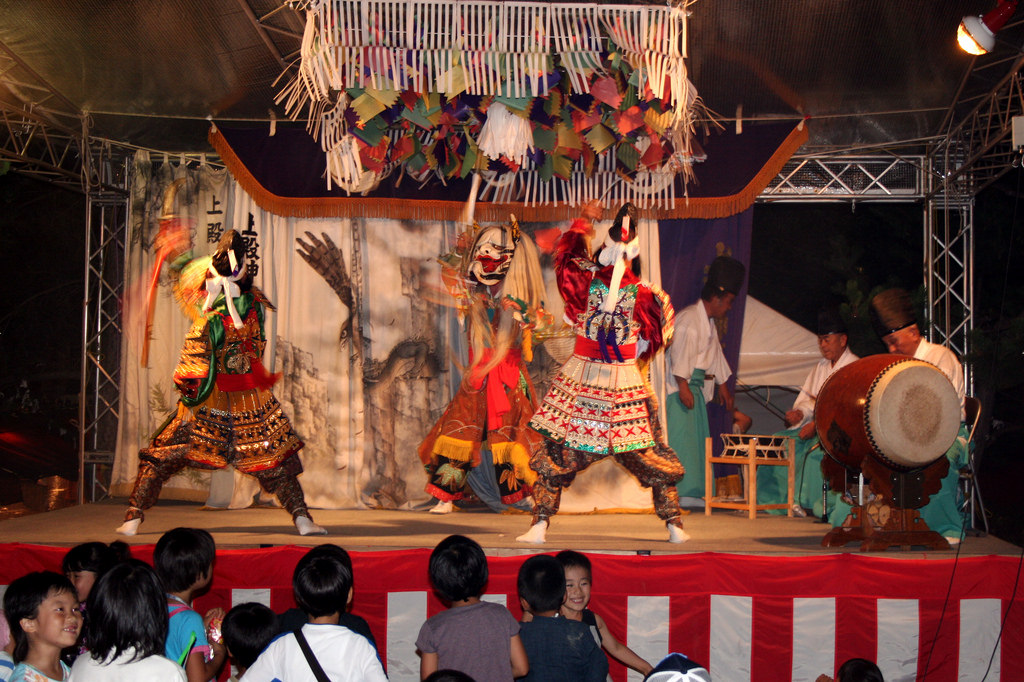Apr 25, 2018
English Language Kagura Performances in Hiroshima

There are a number of styles of dance and performance around Japan that go by the name of “kagura,” but in western Japan the word almost invariably refers to the lively, narrative performances centered on Shimane prefecture’s famous Izumo Shrine. Long popular throughout the Chugoku region (Hiroshima, Shimane, Yamaguchi, Okayama and Tottori prefectures), in recent decades the style has spread nationwide.
Unlike so many other Japanese folk practices and art forms, Izumo-ryu kagura isn’t a cultural fossil, but a thriving concern that involves regular people of all ages in troupes throughout the region. And as a spectacle, it’s hard to beat. Commonly performed after dark at shrine festivals in both the cities and the deepest countryside, the dances recount folktales and elements of Shinto myth. Children crowd the edges of the stage, ready to scream and fall back in terrified pleasure as demons, bandits or dragons burst onto the scene. Never fear, though. In kagura all these villains are ultimately vanquished and driven away. But only after a great deal of frenzied music, flashing blades, flying sparks and a few taunting challenges by the hero.
Visually, kagura is utterly arresting. And the music, a swirling onslaught of drum, gong and flute, is anything but dull. Where many non-Japanese viewers have difficulty is with the stories themselves. Just what is going on? We’re not familiar with these folktales, and the lines are spoken not only in Japanese, but often from behind masks and by winded performers.
But you’re in luck. For the past several years, Hiroshima Prefectural Art Museum has been hosting a regular series of kagura performances for non-Japanese tourists and residents. With the help of no fewer than sixteen local kagura troupes, the performances are performed in Japanese, but are preceded by an English-language introduction to the coming action, and include a running summary of what is happening during the performance itself (on a screen by the stage). After the performance, an interpreter assists with a question and answer session between performers and audience, and visitors can even inspect and try on some of the costumes.
Don’t pass up this chance to get up close to living and local expression of the traditional Japanese arts.
Performances in May 2018
In May, you’ll have three chances to take part. On Sunday, May 6, the Tsunami Kagura Troupe from Aki Oota-cho in northern Hiroshima Prefecture will perform Yamata no Orochi, probably the most famous selection from the traditional repertoire, depicting an epic battle between the storm god Susanoo and an enormous eight-headed serpent.
On Monday, May 21, the same play will be performed, but this time by a troupe from Asakita-ku, giving you a chance to see two different troupes handle the same well-known material.
Finally, on Sunday, May 27, the Ootsuka Kagura Troupe will perform the story Takiyasha-hime, the story of Princess Takiyasha and her quest to avenge the brutal death of her father, a rebel who had established his own province to lessen the burden of the lower classes. The Ootsuka Troupe has been performing for 120 years, and were pioneers in creating the energetic, fast-paced style of kagura that is popular today.
More Information
Time: Doors open at 17:30, performances begin at 18:00, with a question and answer session and opportunities for photos at around 18:45.
Price: 1000 Yen
Location: Hiroshima Prefectural Art Museum, 2-22 Kaminoboricho, Naka Ward, Hiroshima, Hiroshima Prefecture 730-0014
Website (informative and in English): http://www.hiroshima-kagura.com/
Photo courtesy of author


About the author